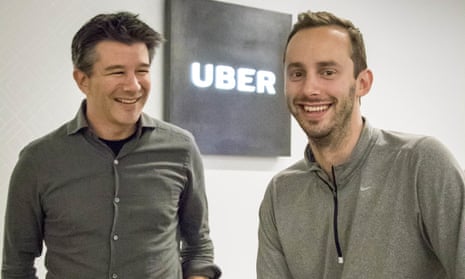The lawsuit filed by Waymo, formerly Google’s self-driving car unit, claiming Uber stole trade secrets has a lot of bad things to say about Anthony Levandowski.
It accuses him of stealing 14,000 confidential files about Waymo’s self-driving technology, including detailed designs of proprietary circuit boards and the laser ranging LiDAR systems, when he was employed there. After covering his tracks, the lawsuit alleges, Levandowski pocketed a multimillion-dollar payout from Google and, using the secrets he had just stolen, promptly set up a new company, Otto, which was acquired shortly after by Uber for around $680m.
Whether the explosive allegations are true has not been decided yet, but what is known is that the brilliant engineer has a history of skirting the rules.
Levandowski, described blandly in the suit as “a former manager” at Waymo, did more than any other person to make Google a world leader in self-driving vehicles.
While working on Google’s Street View maps in 2008, the young engineer built a self-driving Toyota Prius on his own time, using technology developed by his own startup, 510 Systems. He had been working on autonomous vehicles since 2004, when he built a driverless motorcycle for the Grand Challenge, a race for driverless vehicles organised by the Pentagon’s research arm, Darpa. “I didn’t know where this technology was going to be used or how it would work out, but I knew that it was going to change things significantly,” he recalled during an interview in 2016.
“Google was very supportive, but they absolutely did not want their name associated with a vehicle driving in San Francisco,” he said. “They were worried about an engineer building a self-driving car that kills someone and it gets back to Google.”
However, after a successful demonstration in which the driverless Prius delivered a pizza autonomously in the heart of the city, Google’s attitude thawed. Levandowski persuaded the company’s founders, Larry Page and Sergey Brin, to buy 510 Systems and bring the car into a secretive new unit of Google called X dedicated to “moonshot” projects.
Waymo’s lawsuit skips over Levandowski’s formative role altogether, stating only that “Google initiated its self-driving car project in 2009”.
Not everyone at 510 Systems was happy with the sudden change. “I regret how it was handled,” Levandowski said in the 2016 interview. “Some people didn’t make the cut … But it worked out well for most of the people involved.”
Levandowski helped develop more driverless cars for Google, quietly testing them on the streets of California before the state enacted laws requiring permits. “If people asked us what was on the cars, we’d say it’s a laser and just drive off,” he said.
He also found a lobbyist and got involved in getting laws passed in Nevada and California to allow the testing of autonomous vehicles. His backroom lobbying did not endear him to some executives at Google.

“I thought you could just do it yourself,” he said. “Then I found out that there is a team dedicated to that, a process. Got a little bit in trouble for doing it.”
It was perhaps a sign of things to come. After the move to Uber in August, Levandowski was made head of the company’s self-driving efforts. Because he had helped write autonomous vehicles regulations in California, Levandowski thought he spotted a loophole that meant Uber and Otto could get away with not applying for testing permits. Uber deployed self-driving taxis on the streets of San Francisco in December but was forced to pull them off the streets within a week, after the department of motor vehicles called the move illegal and revoked their registrations.
At Google, Levandowski said, he was always chafing at the slow pace of progress. He finally left the company in January 2016, a month after Waymo alleges he had downloaded the technical files, and within days had formed a new company, 280 Systems, which Waymo claims became Otto.
At first, Levandowski planned for his company to make autonomous taxis; in April 2016, a lobbyist for Otto approached the state of Nevada with a plan to shuttle passengers from Las Vegas’s airport to casinos on its famous Strip.
“Sounds like the Google project Anthony has wanted to set up for the last four years,” wrote Bruce Breslow, director of the state’s department of business and industry, in an email to colleagues then. But the plan quickly pivoted to the idea of driverless trucks.
Earlier that year, officials in Palo Alto, California, had received complaints about a truck parked outside Levandowski’s home for weeks at time, with employees constantly coming and going. By April, the reports noted two trucks parked there, making it difficult for his neighbours to put their bins out. Palo Alto issued Levandowski a notice of violations, and he relocated Otto to San Francisco in early May.
Then Otto filmed a promotional video of a truck driving itself near Reno, Nevada, with no one in the front seat. Levandowski wrote at the time that he was “driven by an urgency and deep obligation to accelerate the future”.
But Nevada regulators were furious, noting that Otto had not applied for a testing permit, nor complied with regulations that Levandowski had helped draft. The rules required a human in the driver’s seat and a hefty insurance bond in case anything should go wrong.
“Otto is driving these vehicles illegally and without the required $5m bond that is needed to protect our citizens,” wrote Jude Hurin, an administrator at Nevada’s department of motor vehicles. In the end, the state decided it could not prosecute Otto. After Uber acquired Otto, Nevada even allowed Otto to build the state’s first autonomous vehicle certification centre, which is currently under construction in a Las Vegas suburb.
